Arunashish Datta
Effect of nearby Metals on Electro-Quasistatic Human Body Communication
Oct 06, 2025Abstract:In recent decades Human Body Communication has emerged as a promising alternative to traditional radio wave communication, utilizing the body's conductive properties for low-power connectivity among wearables. This method harnesses the human body as an energy-efficient channel for data transmission within the electro-quasistatic frequency range, enabling advancements in human-machine interaction. While prior work has noted the role of parasitic return paths in such capacitively coupled systems, the influence of surrounding metallic objects on these paths, which are critical for EQS wireless signaling, has not been fully explored. This paper fills that gap with a structured study of how various conducting objects, from non-grounded (floating) metals and grounded metals to enclosed metallic environments such as elevators and cars, affect the body-communication channel. We present a theoretical framework supported by finite element method simulations and experiments with wearable devices. Results show that metallic objects within 20 cm of devices can reduce transmission loss by about 10 dB. When a device ground connects to a grounded metallic object, channel gain can increase by at least 20 dB. Contact area during touch-based interactions with grounded metals produces contact-impedance dependent high-pass channel characteristics. Proximity to metallic objects introduces variability within a critical distance, with grounded metals producing a larger overall effect than floating metals. These findings improve understanding of body-centric communication links and inform design for healthcare, consumer electronics, defense, and industrial applications.
Step-to-Charge: mW-scale power transfer to on-body devices for long channel (> 1m) with EQS Resonant Human Body Powering
Aug 04, 2024Abstract:Current limits of harvested energy in wearables are governed by three fundamental quantities, the physical limits of available energy density in ambient powering, safety limits in intentional powering, and the size of the wearable device. Typical energy harvested, except for solar power in favorable outdoor conditions, ranges from 5 uW to a maximum of 100 - 200 uW depending upon the available energy. Further, traditional intentional powering methodologies using ultrasound and radio-frequency either have a severe limitation in range of powering or are inefficient due to high path loss in Non-Line-of-Sight scenarios due to absorption by the body. In this study, we propose a novel approach using the human body, the common medium connecting the wearable devices, as a channel to transfer power. We demonstrate Human Body Powering using ``Step-to-Charge," a first-of-its-kind non-radiative, meter-scale powering methodology using a floor-based source and the human body as the channel to transfer power at lower channel losses to charge and power wearable devices across the whole body. The proposed powering methodology allows more than 2 mW peak power to be transferred to a wearable device for >1m channel lengths, which is > 90X greater than the state-of-the-art over previous Human Body Powering attempts. Step-to-Charge enables the powering of a new, extended range of wearable devices across the human body, bringing us closer to enabling battery-less perpetual operation using Human Body Power transfer.
Invited: Human-Inspired Distributed Wearable AI
Jun 26, 2024Abstract:The explosive surge in Human-AI interactions, fused with a soaring fascination in wearable technology, has ignited a frenzy of innovation and the emergence of a myriad of Wearable AI devices, each wielding diverse form factors, tackling tasks from health surveillance to turbocharging productivity. This paper delves into the vision for wearable AI technology, addressing the technical bottlenecks that stand in the way of its promised advancements. Embracing a paradigm shift, we introduce a Human-Inspired Distributed Network for Wearable AI, enabled by high-speed ultra-low-power secure connectivity via the emerging 'Body as a Wire' (Wi-R) technology. This breakthrough acts as the missing link: the artificial nervous system, seamlessly interconnecting all wearables and implantables, ushering in a new era of interconnected intelligence, where featherweight, perpetually operating wearable AI nodes redefine the boundaries of possibility.
Efficient Communication and Powering for Smart Contact Lens with Resonant Magneto-Quasistatic Coupling
Jun 12, 2024



Abstract:A two-coil wearable system is proposed for wireless communication and powering between a transmitter coil in a necklace and a receiver coil in a smart contact lens, where the necklace is invisible in contrast to coils embedded in wearables like spectacles or headbands. Magneto-quasistatic(MQS) field coupling facilitates communication between the transmitter in the necklace and the contact lens receiver, enabling AR/VR and health monitoring. As long as the receiver coil remains within the magnetic field generated by the transmitter, continuous communication is sustained through MQS field coupling despite the misalignments present. Resonant frequency tuning enhances system efficiency. The system's performance was tested for coil misalignments, showing a maximum path loss variation within $10 dB$ across scenarios, indicating robustness. Finite Element Method(FEM) analysis has been used to study the system for efficient wireless data transfer and powering. A communication channel capacity is $4.5 Mbps$ over a $1 MHz$ bandwidth. Simulations show negligible path loss differences with or without human tissues, as magnetic coupling remains unaffected at MQS frequencies below $30 MHz$ due to similar magnetic permeability of tissues and air. Therefore, the possibility of efficient communication and powering of smart contact lenses through a necklace is shown for the first time using resonant MQS coupling at an axial distance of $15cm$ and lateral distance of over $9cm$ to enable AR/VR and health monitoring on the contact lens.
Invited: Can Wi-R enable perpetual IoB nodes?
Aug 08, 2023Abstract:While the number of wearables is steadily growing, the wearables/person wearing them faces a limitation due to the need for charging all of them every day. To unlock the true power of IoB, we need to make these IoB nodes perpetual. However, that is not possible with today's technology. In this paper, we will debate, whether with the advent of Wi-R protocol that uses the body to communicate at 100X lower energy that BTLE/Wi-Fi, is it going to be possible to enable the long-standing desire of perpetual sensing/actuation nodes for the Internet of Bodies.
Channel Modeling for Physically Secure Electro-Quasistatic In-Body to Out-of-Body Communication with Galvanic Tx and Multimodal Rx
Apr 27, 2022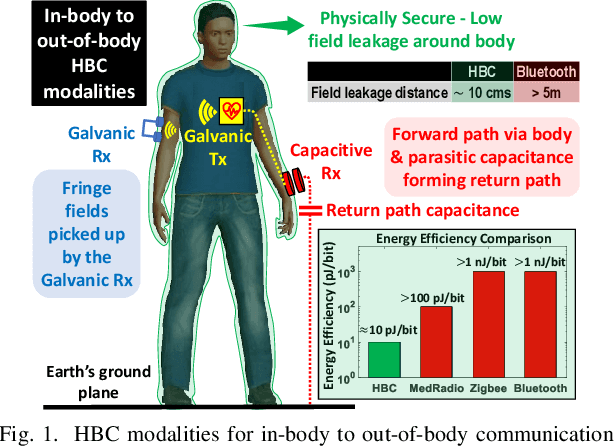
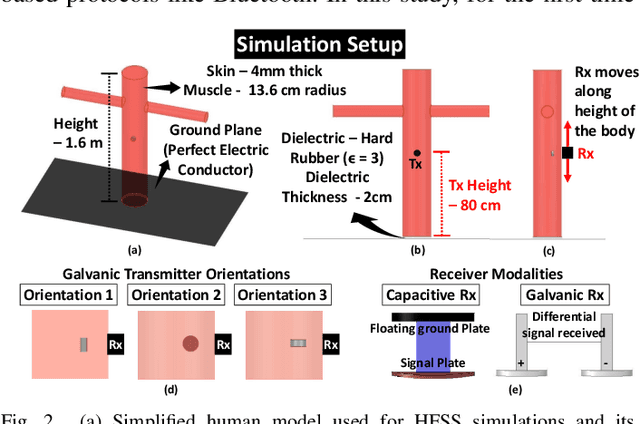

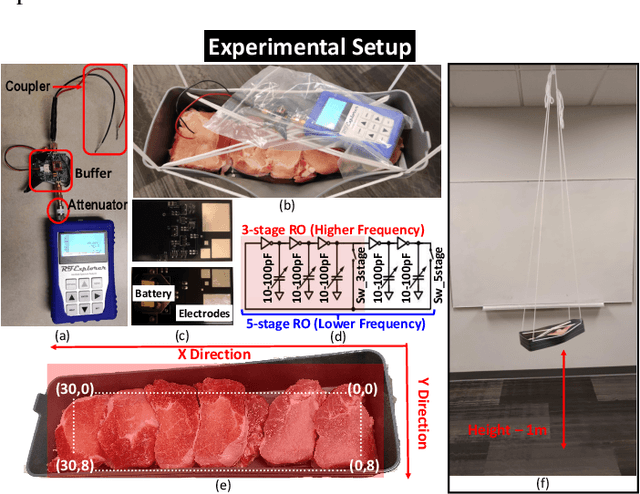
Abstract:Increasing number of devices being used in and around the human body has resulted in the exploration of the human body as a communication medium. In this paper, we design a channel model for implantable devices communicating outside the body using physically secure Electro-Quasistatic Human Body Communication. A galvanic receiver shows 5dB lower path loss than capacitive receiver when placed close to transmitter whereas a capacitive receiver has around 15dB lower path loss for larger separation between the transmitter and receiver. Finite Element Method (FEM) based simulations are used to analyze the communication channel for different receiver topologies and experimental data is used to validate the simulation results.
A Quantitative Analysis of Physical Security and Path Loss With Frequency for IBOB Channel
Apr 27, 2022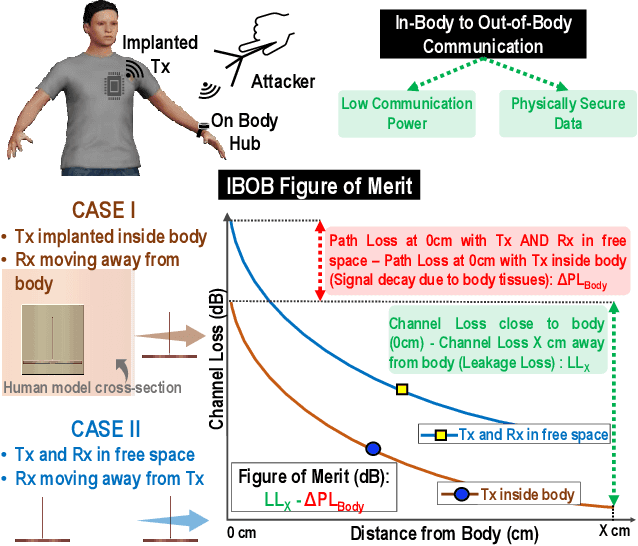
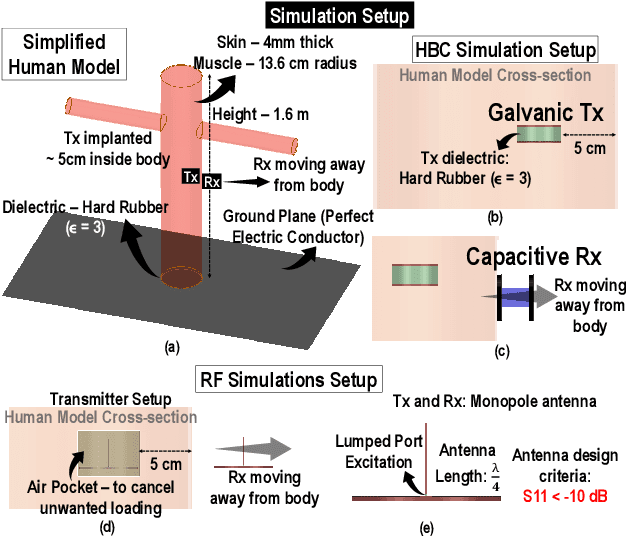

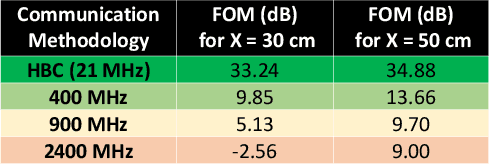
Abstract:Security vulnerabilities demonstrated in implantable medical devices have opened the door for research into physically secure and low power communication methodologies. In this study, we perform a comparative analysis of commonly used ISM frequency bands and human body communication (HBC) for data transfer from in-body to out-of-body (IBOB). We develop a figure of merit (FoM) that comprises of the critical parameters to quantitatively compare the communication methodologies. We perform finite-element method (FEM)-based simulations and experiments to validate the FoM developed.
 Add to Chrome
Add to Chrome Add to Firefox
Add to Firefox Add to Edge
Add to Edge